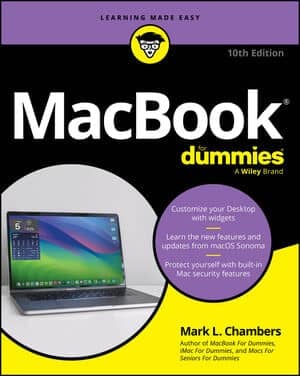There are some striking differences that set the MacBook Air apart from the MacBook Pro, including dimensions, costs, and number of ports. Following is a complete list of these differences:
Physical dimensions: Apple doesn’t call this machine the Air for nothing! The current 11.6-inch Air laptop measures a mere 0.68" in height (at its tallest point) when closed, 11.8" in width, and 7.56" in depth.
Oh, and hold on to your chair for this one: Our champ weighs in at a lightweight 2.38 pounds! (That’s three or four extra pounds you won’t be carrying around all day at that expo. Take it from this traveler: You will feel the refreshing difference in just an hour or two.)
Cost: At the time of this writing, there are two versions of the Air laptop. An entry-level 11-inch MacBook Air will set you back $999, and the top-of-the-line Air is a very reasonable $1,599. The more expensive Air is equipped with a larger screen, a larger solid-state drive and a faster CPU.
(Don’t miss the upcoming coverage on why solid-state is worth every penny — every version of MacBook Air uses solid-state drives, but they’re also available on the MacBook Pro.)
Ports: The $999 Air offers only four ports: two USB 2.0 ports, an audio out jack, and a Thunderbolt port for connecting external peripherals like a monitor or fast external hard drive. There is no FireWire port, which can be a problem for Apple old-timers. The Air also doesn’t have an infrared port, so it’s not compatible with the Apple Remote. Rats.
Sealed case: You can’t add or replace RAM modules. However, a MacBook Air comes equipped with either 2GB or 4GB of RAM, so you should be good to go. Comparatively, MacBook Pro models don’t have sealed cases, and can be upgraded to a maximum of 8GB of RAM.
Solid-state drive: The MacBook Pro also offers a solid-state drive option.
No built-in optical drive: Whoa, Nellie! This is a big one. Apple decided that a typical Air owner is likely to use a wireless connection for transferring files and media, and with the arrival of the Apple App Store, you don’t even need a DVD drive to install Lion!
But what if you have to re-install an application, or install something new? If you need to read or burn discs, a separate external USB SuperDrive is available for about $100, or you can use the Remote Disc feature and share the drive on another computer.
As you can see, these striking differences make the choice between a MacBook Air and a MacBook Pro very easy indeed. To wit: The Air is designed for the traveler who appreciates minimum weight and size but doesn’t want to sacrifice the full-size screen, and full-size keyboard of a typical MacBook.
These folks see the MacBook Air as a race car: nimble, with reduced weight and no unnecessary frills. (Think of a typical NASCAR entry. Who needs an expensive stereo or air conditioning?)
If you prefer instead the additional performance and versatility of a MacBook Pro — including the standard set of ports, the larger 15 and 17-inch screen sizes, the ability to upgrade memory, and a built-in optical drive — stick with the more conventional MacBook Pro. (Sure, you’ll have to live with carrying a few more pounds. Such is the price of performance.)

